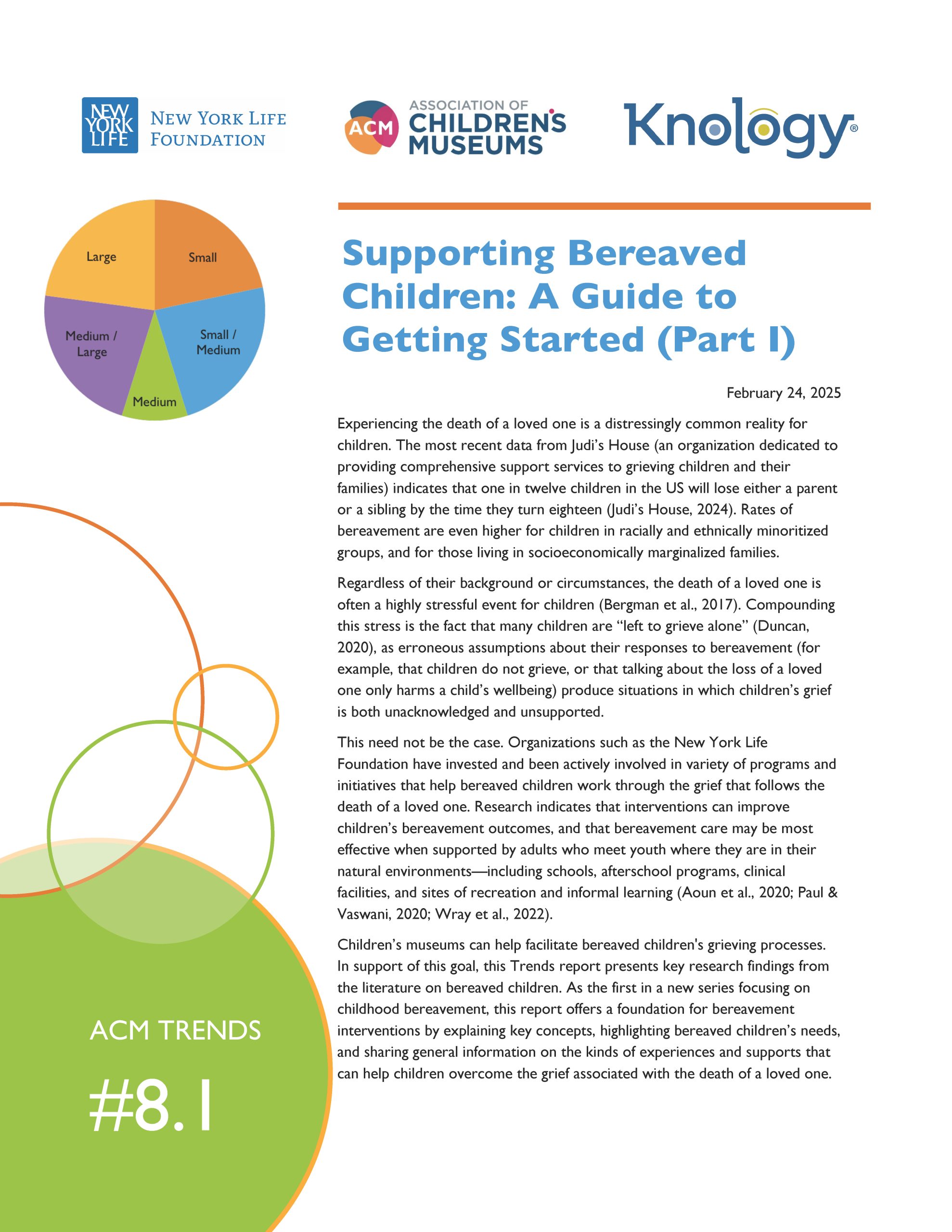
Data from this report was collected through a search of available literature. The research was supported by funding from the New York Life Foundation.
Experiencing the death of a loved one is a distressingly common reality for children. The most recent data from Judi’s House (an organization dedicated to providing comprehensive support services to grieving children and their families) indicates that one in twelve children in the US will lose either a parent or a sibling by the time they turn eighteen (Judi’s House, 2024). Rates of bereavement are even higher for children in racially and ethnically minoritized groups, and for those living in socioeconomically marginalized families.
Children’s museums can help facilitate bereaved children’s grieving processes. In support of this goal, this Trends report presents key research findings from the literature on bereaved children. As the first in a new series focusing on childhood bereavement, this report offers a foundation for bereavement interventions by explaining key concepts, highlighting bereaved children’s needs, and sharing general information on the kinds of experiences and supports that can help children overcome the grief associated with the death of a loved one
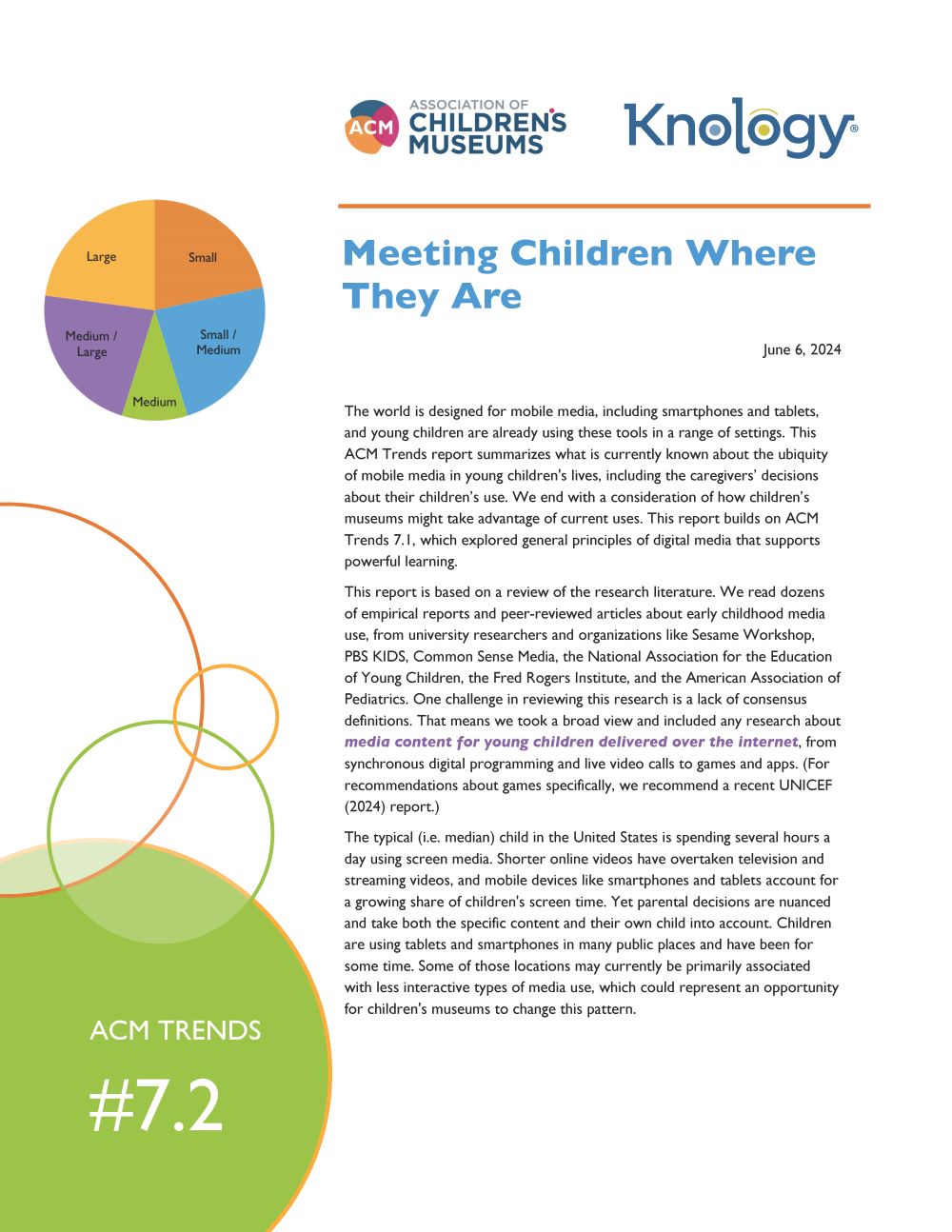
Data for this report was collected through a search of available literature. This research was supported by the Institute for Museum and Library Services.
The world is designed for mobile media, including smartphones and tablets, and young children are already using these tools in a range of settings. This ACM Trends report summarizes what is currently known about the ubiquity of mobile media in young children’s lives, including the caregivers’ decisions about their children’s use. We end with a consideration of how children’s museums might take advantage of current uses. This report builds on ACM Trends 7.1, which explored general principles of digital media that supports powerful learning.
This report is based on a review of the research literature. We read dozens of empirical reports and peer-reviewed articles about early childhood media use, from university researchers and organizations like Sesame Workshop, PBS KIDS, Common Sense Media, the National Association for the Education of Young Children, the Fred Rogers Institute, and the American Association of Pediatrics. One challenge in reviewing this research is a lack of consensus definitions. That means we took a broad view and included any research about media content for young children delivered over the internet, from synchronous digital programming and live video calls to games and apps.

Data for this report was collected through a review of existing literature. This research was supported by the Institute for Museum and Library Services.
When designed well, virtual programming and online experiences can facilitate meaningful learning moments in early childhood.
This ACM Trends report focuses on these digital media as one educational tool in the museum toolkit. Several well-regarded early childhood organizations have endorsed particular uses of media even for very young children, and we explore the principles and the research behind them before turning to criteria that can help identify when media is the right tool. ACM Trends 7.2 will build on this report by looking at empirical questions that must inform design: how often children use media, which children use media, and where children use media.
This Trends report reviews the research findings and concludes with practical advice for children’s museums seeking to design meaningful digital media experiences for young children.
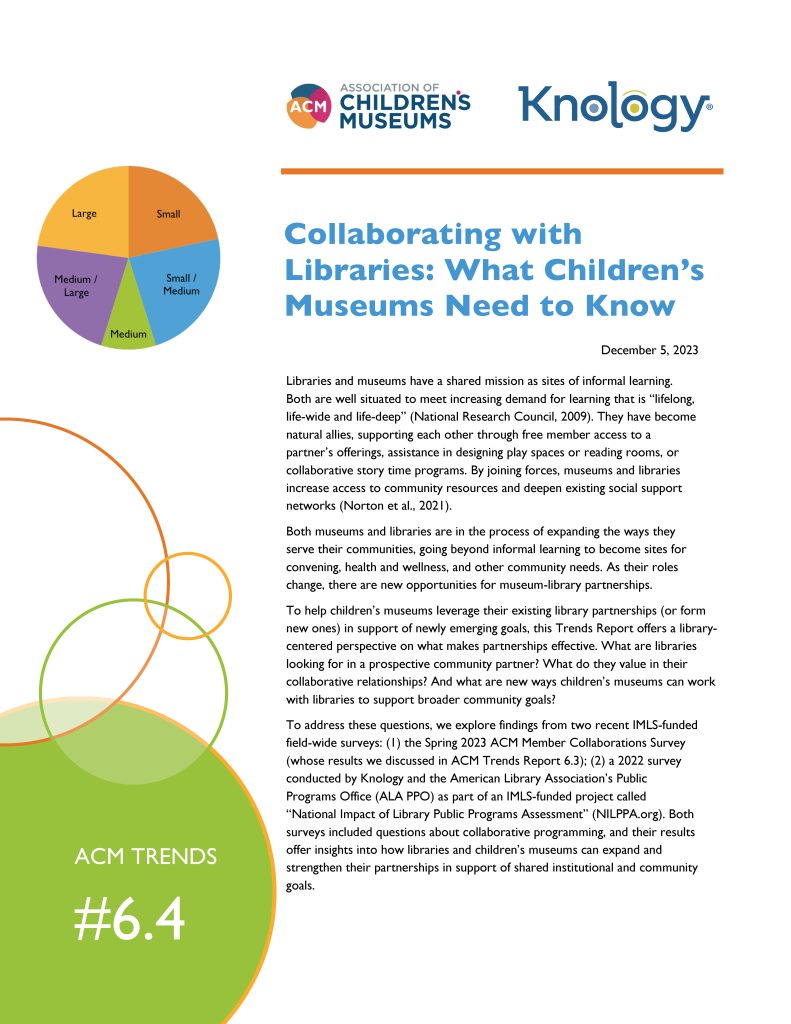
Data for this report comes from two surveys. That pertaining to children’s museums’ collaborations with libraries was collected through the Spring 2023 ACM Member Collaborations survey. The dataset contains information from 59 member institutions. Data on library collaborations with museums was collected through a NILPPA survey of US libraries conducted in 2022. This dataset contains information from 314 libraries. Research for both of these projects is supported by the Institute for Museum and Library Services (Grant #s: MG-251839-
OMS-22; MG-80-19-0042-19; LG-250153-OLS-21).
Libraries and museums have a shared mission as sites of informal learning.
Both museums and libraries are in the process of expanding the ways they serve their communities, going beyond informal learning to become sites for convening, health and wellness, and other community needs. As their roles change, there are new opportunities for museum-library partnerships. To help children’s museums leverage their existing library partnerships (or form new ones) in support of newly emerging goals, this Trends Report offers a library centered perspective on what makes partnerships effective. What are libraries looking for in a prospective community partner? What do they value in their collaborative relationships? And what are new ways children’s museums can work with libraries to support broader community goals?
The survey also offered insights into the goals children’s museums are pursuing through collaboration. Though varying considerably, museums’ collaborative goals are connected to three broadly shared aims: (1) healing; (2) learning; (3) community. In what follows, we discuss how these findings can help children’s museums understand, approach, and evaluate collaborative work. Our hope is that sharing this information will not only stimulate dialogue around collaboration and partnership, but also help children’s museum leaders plan new collaborative programs and begin the process of building relationships with new partners.
To address these questions, we explore findings from two recent IMLS-funded field-wide surveys: (1) the Spring 2023 ACM Member Collaborations Survey (whose results we discussed in ACM Trends Report 6.3); (2) a 2022 survey conducted by Knology and the American Library Association’s Public Programs Office (ALA PPO) as part of an IMLS-funded project called “National Impact of Library Public Programs Assessment” (NILPPA.org). Both surveys included questions about collaborative programming, and their results offer insights into how libraries and children’s museums can expand and strengthen their partnerships in support of shared institutional and community goals.

Data for this report comes from two surveys. That pertaining to children’s museums’ collaborations with libraries was collected through the Spring 2023 ACM Member Collaborations survey. The dataset contains information from 59 member institutions. Data on library collaborations with museums was collected through a NILPPA survey of US libraries conducted in 2022. This dataset contains information from 314 libraries. Research for both of these projects is supported by the Institute for Museum and Library Services (Grant #s: MG-251839-
OMS-22; MG-80-19-0042-19; LG-250153-OLS-21).
Libraries and museums have a shared mission as sites of informal learning.
Both museums and libraries are in the process of expanding the ways they serve their communities, going beyond informal learning to become sites for convening, health and wellness, and other community needs. As their roles change, there are new opportunities for museum-library partnerships. To help children’s museums leverage their existing library partnerships (or form new ones) in support of newly emerging goals, this Trends Report offers a library centered perspective on what makes partnerships effective. What are libraries looking for in a prospective community partner? What do they value in their collaborative relationships? And what are new ways children’s museums can work with libraries to support broader community goals?
The survey also offered insights into the goals children’s museums are pursuing through collaboration. Though varying considerably, museums’ collaborative goals are connected to three broadly shared aims: (1) healing; (2) learning; (3) community. In what follows, we discuss how these findings can help children’s museums understand, approach, and evaluate collaborative work. Our hope is that sharing this information will not only stimulate dialogue around collaboration and partnership, but also help children’s museum leaders plan new collaborative programs and begin the process of building relationships with new partners.
To address these questions, we explore findings from two recent IMLS-funded field-wide surveys: (1) the Spring 2023 ACM Member Collaborations Survey (whose results we discussed in ACM Trends Report 6.3); (2) a 2022 survey conducted by Knology and the American Library Association’s Public Programs Office (ALA PPO) as part of an IMLS-funded project called “National Impact of Library Public Programs Assessment” (NILPPA.org). Both surveys included questions about collaborative programming, and their results offer insights into how libraries and children’s museums can expand and strengthen their partnerships in support of shared institutional and community goals.
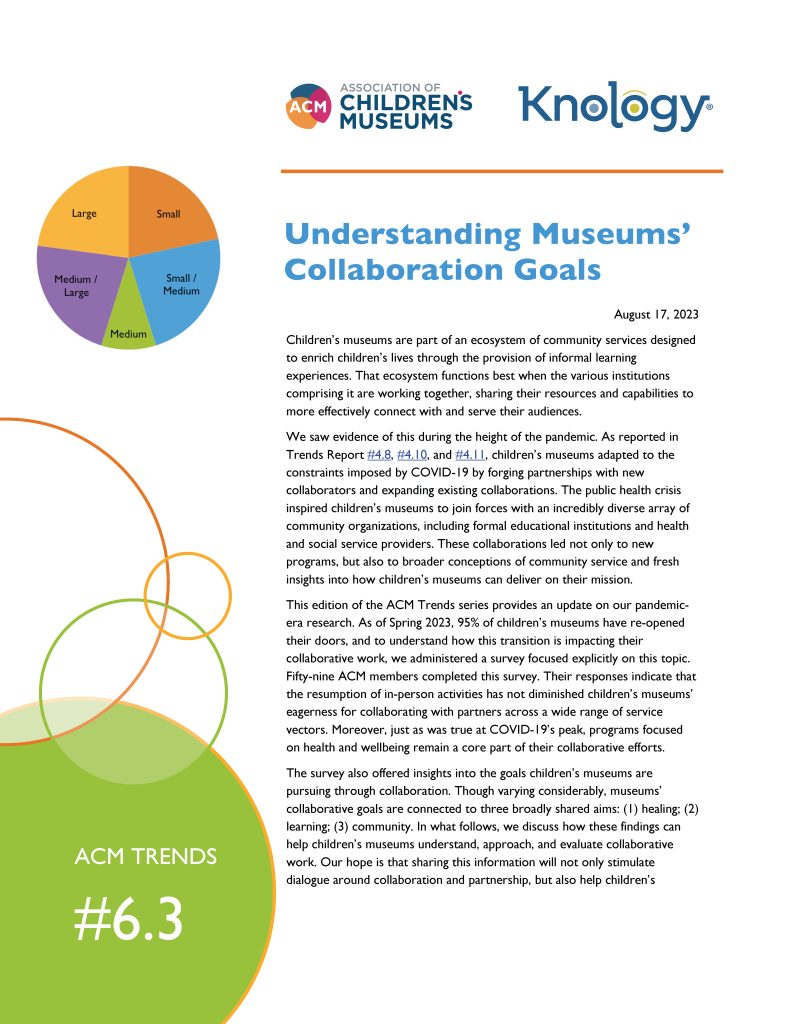
Data for this report was collected through a Spring 2023 ACM member survey on collaborations. The dataset contains information from 59 member institutions. Previous pandemic-era survey data on collaborations conducted during the height of the COVID-19 pandemic supported instrument sevelopment. This research was supported by the Institute for Museum and Library Services
Children’s museums are part of an ecosystem of community services designed to enrich children’s lives through the provision of informal learning experiences. That ecosystem functions best when the various institutions comprising it are working together, sharing their resources and capabilities to more effectively connect with and serve their audiences.
We saw evidence of this during the height of the pandemic. As reported in Trends Report #4.8, #4.10, and #4.11, children’s museums adapted to the constraints imposed by COVID-19 by forging partnerships with new collaborators and expanding existing collaborations. The public health crisis inspired children’s museums to join forces with an incredibly diverse array of community organizations, including formal educational institutions and health and social service providers. These collaborations led not only to new
programs, but also to broader conceptions of community service and fresh insights into how children’s museums can deliver on their mission.
This edition of the ACM Trends series provides an update on our pandemic-era research. As of Spring 2023, 95% of children’s museums have re-opened their doors, and to understand how this transition is impacting their collaborative work, we administered a survey focused explicitly on this topic. Fifty-nine ACM members completed this survey. Their responses indicate that the resumption of in-person activities has not diminished children’s museums’ eagerness for collaborating with partners across a wide range of service vectors. Moreover, just as was true at COVID-19’s peak, programs focused on health and wellbeing remain a core part of their collaborative efforts.
The survey also offered insights into the goals children’s museums are pursuing through collaboration. Though varying considerably, museums’ collaborative goals are connected to three broadly shared aims: (1) healing; (2) learning; (3) community. In what follows, we discuss how these findings can help children’s museums understand, approach, and evaluate collaborative work. Our hope is that sharing this information will not only stimulate dialogue around collaboration and partnership, but also help children’s museum leaders plan new collaborative programs and begin the process of building relationships with new partners.

Data for this report was drawn from publicly available IRS Form 990s posted on Candid and the ProPublica nonprofit look-up tools. Supplemental data was collected through the Spring 2022 ACM member survey.
Since 2019, ACM and Knology have been working to create a data-based resource geared toward helping children’s museums learn about emerging trends across the field. The result of our efforts is the ACM Trends Data Hub—an online portal that visualizes trends in museum attendance, income, expenses, and staffing from 2016 to the present. Created with data from ACM member surveys and the publicly available US tax Form 990s that all US non-profits are required to complete every year, the Data Hub displays individual museum information that can be filtered by size, ACM member level, US region, and by city and state. As a management tool, the Data Hub allows children’s museums to monitor their performance across the aforementioned indicators, and to compare this to other institutions and sector-wide trends. Though at present the Data Hub only features US-based museums, the ACM Trends team will aim to incorporate data from museums outside the US in the future.
To facilitate the Data Hub’s use, this ACM Trends Report highlights one of its most important features: the use of median values to express sector-wide trends. Whenever highlighting sectoral averages in attendance, income, expenses, or staffing, the Data Hub uses median values. This is because medians are often preferrable to other ways of computing averages (like the statistical mean or mode) when it comes to museum data.
In this report, we explain why medians are so often the best way of identifying trends and tendencies for museums. Using examples from our research, we illustrate how museum data is often distorted by statistical outliers that make mean values less representative of the tendencies that most museums might see. This is the reason that medians offer a more accurate reflection of what a “typical” children’s museum should expect in their context.
By understanding what median values suggest, children’s museums will be better positioned to use the Data Hub to understand their financial positions, to support accountability to their funders based on industry norms in comparison to local conditions, and to assess performance compared to their peers.

This post originally was published by Knology. Access the article here: Museum Virtual Programming after COVID-19 – Knology
Children’s museums responded to the COVID-19 shutdowns of 2020 and 2021 by developing new forms of programming, delivered through virtual platforms. At the pandemic’s outset, the Association of Children’s Museums (ACM) launched “Children’s Museums at Home,” a website providing families with links to virtual programs created by ACM member museums. Following up on this, individual children’s museums developed a number of other virtual strategies. They live-streamed, produced podcasts and YouTube videos, developed online games and contests, and distributed digital newsletters.
Initially, these different forms of virtual programming were envisioned as temporary adjustments—as necessary adaptations to a short-term crisis. Yet moving online taught children’s museums that the use of digital technologies and virtual spaces could have long-term benefits. In particular, they offered a way to reach new audiences—including those historically lacking access to children’s museums. With the resumption of in-person activities, many are asking what aspects of these virtual services should be retained. How much virtual programming do audiences want? How much potential is there for reaching new audiences with this programming? How might this be managed given children’s museums’ limited budgets? And how would these efforts relate to in-person programming?
In 2021, as more and more children’s museums migrated to online spaces, Knology and ACM began gathering data on all aspects of digital content creation. In addition to this, we held a workshop for children’s museum leadership to discuss the strengths, weaknesses, opportunities, and threats of continued virtual programming in a post-COVID world. Concurrently, Rockman et. al. conducted survey research to learn about parents’ and caregivers’ experiences with and preferences for different types of virtual programming, and to determine how much demand for this there would be after children’s museums resumed in-person operations.
In 2022, the ACM Trends Reports team documented both the benefits and challenges associated with continued virtual programming efforts. These reports indicate that both children’s museum leaders and patrons want virtual programming to outlive the COVID-19 pandemic. The challenge for leaders is now to make future investments that support community needs, and reach new audiences without adversely impacting children’s museums’ capacities.
To support the field, ACM, Knology’s Trends team, and Rockman et. al. received funding from the Institute for Museum and Library Services (IMLS) to pursue “Post-Pandemic Virtual Experiences with Children’s Museums: Responding to Family, Educator, and Museum’s Needs and Expectations.” We’re calling it the Museum’s Virtual Programming project, for short (MVP).
MVP aims to provide children’s museums with actionable data that can help them decide whether and how virtual programming might best meet the needs of the communities they serve. The project will also explore how ACM can create opportunities for asset sharing and development tools to optimize virtual programming for children’s museums of all sizes—along with their community partners.
This three-year project will assess the virtual programming assets and needs of the children’s museum community by working, first and foremost, with the ACM membership, and by speaking with families, parents, caregivers, and local educators across the country to help build recommendations that can align with the scale and operations of children’s museums of all sizes. In Fall 2022, our team will be developing baseline instruments and criteria for a cohort of ten ACM member museums who will work with their audiences and community partners to facilitate data collection. This data collection will begin in Spring 2023, and will be led by Rockman et al. Concurrent with this, ACM and Knology will begin diving deeper into ACM member museum’s virtual programming offerings.
As with all ACM, Knology, and Rockman et al initiatives, the team will center its work in principles of equity. Although the shift to online programming has not been as easy for those living in marginalized communities, that does not discount the value of online for all. Together, the team will consult with children’s museum member families, early childhood educators, and those who lack access to children’s museums or live in traditionally underserved communities.
Together, we believe that a collaborative approach can create a path to better meet the needs of those audiences who have historically not been able to access children’s museums, and to help all institutions within this field extend their reach and services.
To review the fifth volume of ACM Trends Reports, please click here.

| This post was originally published as ACM Trends Report 6.1, the first report in the sixth volume of ACM Trends Reports, produced in partnership between ACM and Knology. |
Members are the lifeblood of many children’s museums. They are loyal patrons who trust museums to provide playful learning opportunities for their children, often complementing trips to the zoo or aquarium. But when children “age out,” families may turn to other cultural institutions and start to reconsider the value of their membership. Understanding value seekers’ calculations can help children’s museums cultivate trust through transparency.
In this Trends report, we look at what membership pricing and attendance data can tell us about children’s museums. We focus on what museums might want to think about when attempting to stabilize their membership base, and on how to forge trusting relationships with prospective members.
National data related to membership pricing has been of particular interest to the ACM leadership community in recent years, especially as it relates to post-pandemic operations. Prompted by a specific request from an ACM member, this report contributes to these ongoing discussions. We used data from the Spring 2022 targeted ACM member survey and collected additional information from member museum websites. We developed a dataset from 90 children’s museums to see if there were differences in membership costs between small, medium, and large museums. We also compared admission prices across these categories and calculated a “pay less” point—that is, the number of times a family of four would need to visit in order to make the
purchase of an annual membership a cost-saving act.
Our analysis yielded two main findings. First, even though admission prices and membership costs are highest for large museums, the number of single visits needed by a family of four to “pay less” is lower for these museums than it is for their small and medium-sized counterparts. Second, we confirmed that admission prices and membership costs tend to rise in parallel, which means that even though base admission prices may be determined based on local cost of living concerns, ACM members can still compare their rates to other children’s museums, Taken together, these findings can help children’s museums determine how to align pricing decisions with the needs and interests of value-seeking visitors—that is, those who purchase memberships based on a calculation of savings.
In Spring 2022, the ACM Trends Team circulated a survey to ACM member institutions requesting data on attendance, admission prices, membership costs, and other operations. After supplementing this data with information gleaned from member websites in August 2022, we assembled a dataset of 90 museums (30 of each size). We summarize the data in Table 1 below.
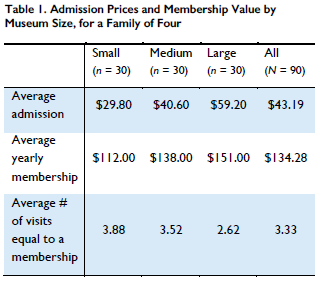
Table 1 compares admission and membership prices for a family of four at small, medium, and large museums. Admission prices are based on the general admission price for adults and children. When prices for adults and children were different, a family of four was calculated with two adults and two children.
We calculated these figures for a two-adult, two-child family on account of current US Census data (which shows that the average US family contains 3.13 people), and because this aligns with demographic research showing that a plurality of mothers in the US today report having two children (Pew Research Center, 2015).
The bottom row in Table 1 presents the average number of times a family of four would need to pay admission before achieving cost-savings through a membership purchase. The fourth column illustrates the mean cost across all size categories—which is an appropriate way to calculate averages in a dataset like this one, as it contains few outliers.
Clearly, the larger the museum, the higher the membership and admission costs for a family of four. Nevertheless, the number of visits needed for a valueseeker to “pay less” for multiple visits through a membership is lower (2.62) for large museums than for their small (3.88) and medium-sized (3.52) counterparts.
Figure 1 presents data from the bottom row of Table 1 as a “box and whiskers” plot. To create this, we “normalized” pricing data to show membership costs (for a family of four) as a multiple of admission costs for each children’s museum. The “box” part of the plot illustrates the middle half of the data (in other words, where 15 of the 30 museums in each size category sit), while the “whiskers” indicate those museums where prices are higher or lower than their peers.
When a museum stands alone compared to others, the box and whiskers plot expresses this with dots, considered outliers. When multiple museums lie in the same range, this is indicated by a line placed above the box. The line in the middle of the box illustrates the median, or the exact middle of all of the data in that category. We can see from those lines that medium-sized and small museums tend to be near one another. To see how many visits a family of four would need to make before generating savings through the purchase of a membership, look at the Y-axis, which plots the ratio of membership costs to visit price. This data can be used as a foundation for making decisions about membership pricing, especially in connection with data on premiums.
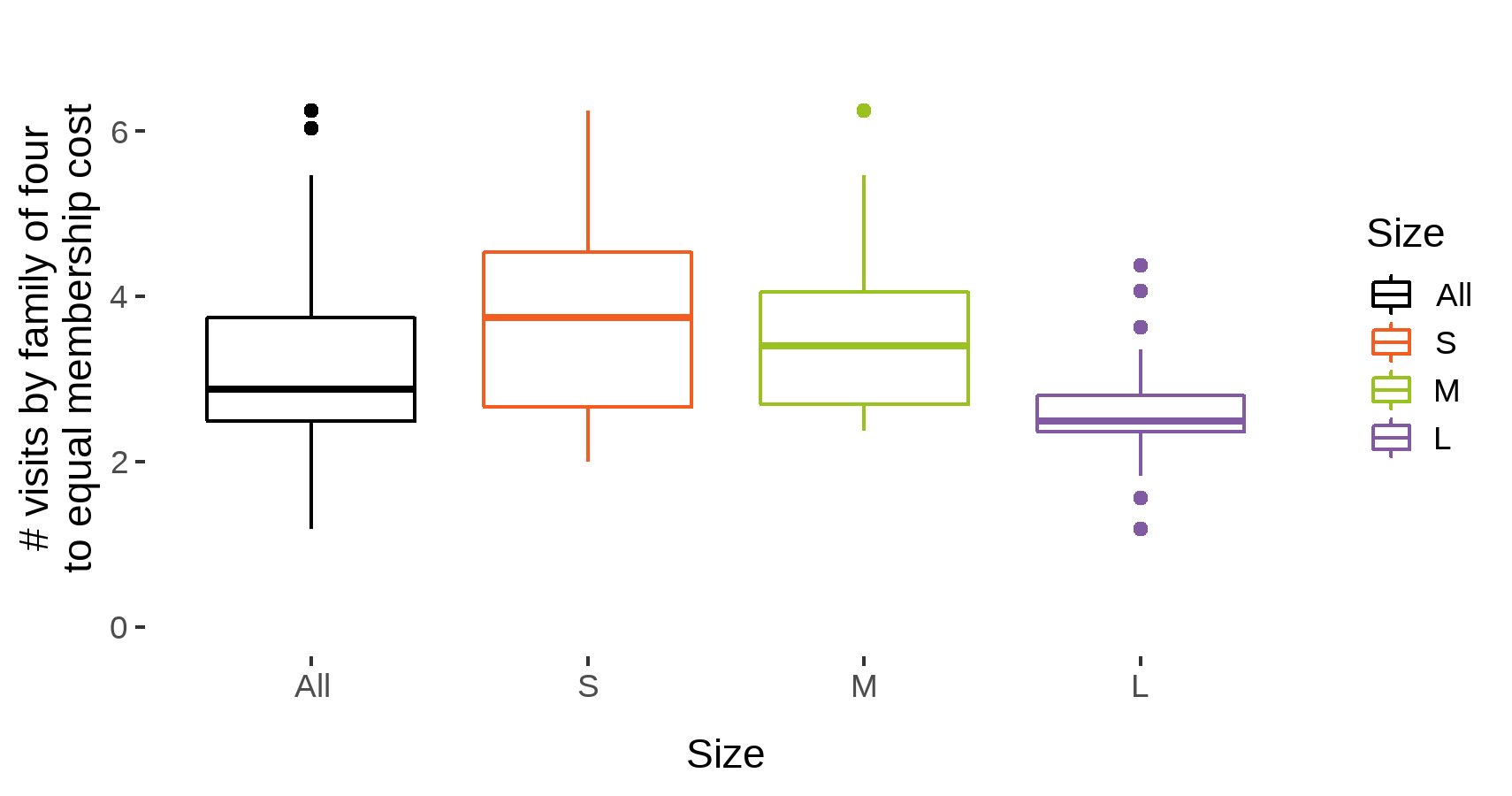
We also collected data on additional benefits provided with museum memberships—for example, discounts for rentals or birthday parties (n = 60), member-only events (n = 53), and reciprocal admission to other ACM (n = 24) or ASTC (n = 13) member institutions. Most museums offer these in some form; 8 out of 10 small museums, 9 out of 10 medium-sized museums, and all large museums indicated additional membership benefits. The total number of additional benefits did not appear to be related to a higher value of memberships.
One benefit, however, did have a significant effect on “trips to match cost.” Offering a discount on space rentals, after accounting for museum size, was related to higher membership costs. Though some have suggested that early access or discounts on summer camps are perceived as an incentive for families who can afford summer camp experiences, our analysis did not provide any evidence that the benefit is related to higher or lower membership prices.
We also looked at a subset of the data from fifty-one museums (1 small, 15 medium-sized, 20 large, and 3 yet to be classified) who responded to the Spring 2022 ACM member survey and provided information on annual attendance and member attendance from FY2016 to FY2021. Looking at the data, we can determine historical trends in museum attendance, and also calculate the proportion of overall attendance consisting of museum members.
Prior to the pandemic, in FY2016 through FY2019, the median number of memberships purchased per year for these museums was between 2200 and 3000. In FY2020 and FY2021, this value dropped to 968 & 1188 memberships purchased, respectively. Along with this decline, the proportion of overall visitors who were
museum members decreased roughly 6% in 2021 for these museums. While these museums are just a portion of the overall ACM field, the decline likely reflects the impact of the pandemic across the sector.
People purchase museum memberships for different reasons. These purchases provide a reason for frequent visits—which not only benefits children but can also help museum leaders advocate for children’s access to the healthy spaces of learning and discovery children’s museums provide. For some, a membership is a valueseeking purchase, one made through a consideration of future costs, benefits, and savings. Value-seekers become members because they want museum-going to be a regular part of their children’s lives. These pricing data tell us that museums anticipate four visits a year by their value-seeking members, setting prices that justify at least four or more visits in a membership year.
For others, purchasing a membership may not be driven by monetary concerns. They may simply want to invest in an institution that is doing good work, or to support a local institution that is good for children. Some individuals may purchase memberships to build social capital, because they want to support an organization whose values they identify with, and because they want their membership to reflect something about who they are. They may also become members because they want to encourage their grandchildren, nephews, nieces, or other relatives to visit them, or because they want to provide gifts to families with children. These “affinity members” may also care less about free admission than about membership perks, premiums, or about symbolic value—for example, discounts on birthdays or group tours, reciprocal admission at other ACM member museums or other cultural institutions, access to priority registration, exclusive programs, or behind-the-scenes content.
In other words, value is a complex, multidimensional thing. When thinking about those who see the primary value of a museum as its price, children’s museum leaders can also consider how decisions related to pricing might impact the perceived trustworthiness of their institutions. As ACM Trends #5.3 discussed, in order to cultivate public trust, museums need to demonstrate competence, reliability, sincerity, integrity, and benevolence. During the height of the pandemic, many museums demonstrated benevolence through refunds or by pro-rating existing memberships. At present, some museums are considering increased fees to recoup pandemic-related monetary losses. Doing so may risk the trust built through the pandemic, especially as cost-of-living increases may make more members value-seekers.
Data for this report was collected through: (1) an online survey distributed by ACM in April 2022; (2) a review of ACM member institutions’ websites. This dataset contains information from 90 current ACM member museums.
Our analysis used the size categories developed in ACM Trends Reports #1.1 and #1.7. We use these categories because institutional size predicts a range of outcomes for children’s museums. We note that museums offer many types of reduced priced tickets or free admission, and some unique premiums that were not used in this analysis.
Voiklis, J. (2022). Key Concepts: Trust. ACM Trends 5(3). Livingston, G. (2015). “Childlessness Falls, Family Size Grows Among Highly Education Women.” Pew Research Center.
US Census Bureau (2021). America’s Families and Living Arrangements. Retrieved from: [https://www.statista.com/statistics/183657/average-sizeof-
a-family-in-the-us/]
This project was made possible in part by the Institute of Museum and Library Services. The views, findings, conclusions or recommendations expressed in this publication do not necessarily represent those of the Institute of Museum and Library Services.
The Associations of Children’s Museums (ACM) champions children’s museums worldwide. Follow ACM on Twitter, Facebook, and Instagram. Knology produces practical social science for a better world. Follow Knology on Twitter.